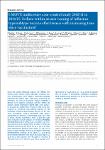I-MOVE multicentre case–control study 2010/11 to 2014/15: Is there within-season waning of influenza type/subtype vaccine effectiveness with increasing time since vaccination?
Kissling, Esther
Nunes, B.
Robertson, C.
Valenciano, Marta
Reuss, Annicka
Larrauri, A.
Cohen, J. M.
Oroszi, B.
Rizzo, C.
Machado, Ausenda
Pitigoi, Daniela
Domegan, L.
Paradowska-Stankiewicz, I.
Buchholz, Udo
Gherasim, A.
Daviaud, I.
Horváth, Judit K.
Bella, A.
Lupulescu, E.
O'Donnell, J.
Korczyńska, M.
Moren, A.
Since the 2008/9 influenza season, the I-MOVE multicentre case–control study measures influenza vaccine effectiveness (VE) against medically-attended influenza-like-illness (ILI) laboratory confirmed as influenza. In 2011/12, European studies reported a decline in VE against influenza A(H3N2) within the season. Using combined I-MOVE data from 2010/11 to 2014/15 we studied the effects of time since vaccination on influenza type/subtype-specific VE. We modelled influenza type/subtype-specific VE by time since vaccination using a restricted cubic spline, controlling for potential confounders (age, sex, time of onset, chronic conditions). Over 10,000 ILI cases were included in each analysis of influenza A(H3N2), A(H1N1)pdm09 and B; with 4,759, 3,152 and 3,617 influenza positive cases respectively. VE against influenza A(H3N2) reached 50.6% (95% CI: 30.0–65.1) 38 days after vaccination, declined to 0% (95% CI: -18.1–15.2) from 111 days onwards. At day 54 VE against influenza A(H1N1)pdm09 reached 55.3% (95% CI: 37.9–67.9) and remained between this value and 50.3% (95% CI: 34.8–62.1) until season end. VE against influenza B declined from 70.7% (95% CI: 51.3–82.4) 44 days after vaccination to 21.4% (95% CI: -57.4–60.8) at season end. To assess if vaccination campaign strategies need revising more evidence on VE by time since vaccination is urgently needed.
Dateien zu dieser Publikation
Keine Lizenzangabe

